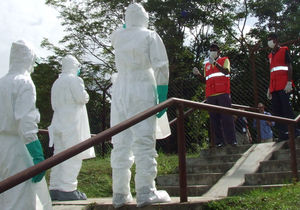Slightly over a week ago, I was trying to write an article for this blog about how health issues could impact logistics. I just could not make it work: the main health impact on logistics would be from a pandemic, and although that seemed pretty realistic to me, I also felt that my readers would probably not see it as realistic enough to spare it a second thought. That was a real issue for me, because the main reason why I wanted to write the post was to get people thinking about logistics contingency planning for a pandemic.
Of course, I am now kicking myself for not have written what would have been a fairly prophetic post – and perhaps have influenced one or two people to take some action.
So my apologies for being late – let’s just say that this is a mistake I will not make very soon again.
The impact
Let’s just assume for the moment that swine flu will go pandemic. What effects will this have on our supply chains?
The most obvious one is that it will put severe demands on it. We will need to have massive amounts of medical goods at the right spot, at the right moment. How to deal with this issue merits a separate post, which you can find here.
Perhaps more insidious is the fact that every supply line depends on people – and in case of a flu pandemic, many of those people will be incapacitated (by illness or death), or be subject to isolation or quarantine. This will mean a severe blow for many of our supply chains: without truck drivers, store managers, clerks, and purchasers, our supply lines will soon break down.
Furthermore, quarantine measures might also mean that transport will be infinitely more difficult: if we can’t have trucks or planes come into the country where we work, goods will not come in either.
How to deal with it
So how to deal with this? At this stage, preparation would include four steps.
The most important issue, which needs immediate action, is to prioritise our logistics: which goods for which programmes are most needed. I would suggest to divide them into three to five groups, ranging from “immediately indispensable” to “doesn’t matter if it’s a couple of months late”. Note that we are not talking about articles here, but about article/programme groups: article 1 for programme X might be in a different group than the same article for programme Y. This needs to be done now: you do not want to have these discussions while you are in the middle of a crisis.
A second issue that needs to be dealt with concurrently with the prioritisation, is a sensitivity analysis of our supply chains: which parts our supply chains will be most vulnerable to disruption? It could be very helpful to develop a couple (not too many) scenarios and see how they impact our supply chains. When doing this, don’t forget that our supply chains extend beyond our own organisation: include the possibility that e.g. your main supplier will be severely impacted, or that your main transporter will be knocked out. Also look outside the logistics departments, e.g. by taking into account that your programme staff might be so severely overburdened that they will no longer be able to make forecasts or report regularly.
Based on the prioritisation and the sensitivity analysis, prepare contingency plans that deal with the various scenarios in such a way that (as far as possible) goods from the highest priority groups will be where they are needed, when they are needed. These contingency plans could include e.g. stockpiling (explicitly taking the risk of increased expiries), already hiring extra staff, and many other possible actions. What it exactly will entail for your organisation will depend on many factors, and there is definitely no one-size-fits-all solution. It will be important here to think laterally and come up with creative solutions: this is an extraordinary situation, and will need extraordinary solutions.
The fourth and last step is resourcing and communication: make sure that you have the (financial) resources to implement your contingency plans – which will mean that you will need to ‘sell’ your plans now to senior management of your organisation – and communicate the plans to all people involved, which would include practically everyone within your organisation, and quite a number of people outside it.
I can hardly stress enough that these steps need to be taken now: if and when the crisis arrives, it will be too late. You might counter that nothing ever goes according to plan, and that the crisis that will really happen is unlikely to be the one you planned for; that might be true, but having these plans and resources at the ready will give you an enormously increased resiliency that will enable you to cope much better than otherwise. To quote general Dwight D. Eisenhower: “plans are nothing; planning is everything”.
A call for action
Go now to the person(s) responsible for logistics planning in your organisation, and ask them whether they have prepared contingency plans for a severe pandemic impacting on your supply chain. And don’t let them get away with generalities; things are much too serious for that. And if you yourself are responsible: did you do your homework? Finally: please come back here and let us know what you did: at this stage, we should all learn from each other.
{




